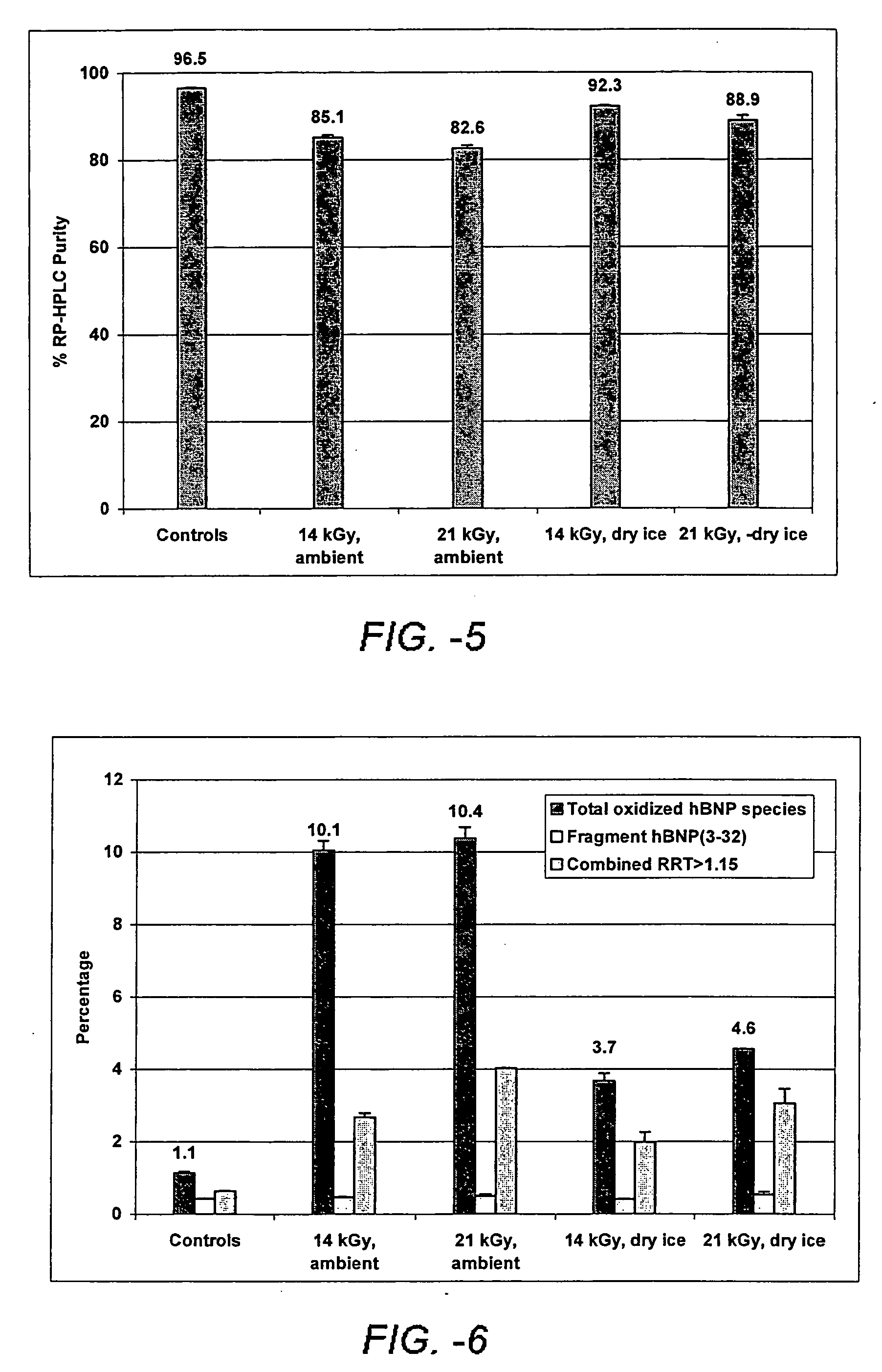Method for terminal sterilization of transdermal delivery devices
a technology of transdermal delivery and terminal sterilization, which is applied in the direction of disinfection, bandages, peptide/protein ingredients, etc., can solve the problems of poor patient compliance, limited application of transdermal delivery, and approximately one million hospitalizations a year, and achieve the effect of reducing the moisture content inside the packaging
- Summary
- Abstract
- Description
- Claims
- Application Information
AI Technical Summary
Benefits of technology
Problems solved by technology
Method used
Image
Examples
example 1
[0156] A formulation comprising 4:1 sucrose:BNP was coated onto MF1035 microprojection members (Macroflux®, available from Alza Corporation, Mountain View, Calif.). The microprojection members were packaged with a nitrogen purge and subjected to gamma irradiation doses of 14 and 21 kGy under dry ice and ambient temperatures. The total purity results are shown in FIG. 5. FIG. 6 summarizes the degradation product profile (as measured by a validated reverse phase, high-pressure liquid chromatography “RP-HPLC” method). This example shows that samples irradiated at 14 kGy under dry ice lost only 4.2% total purity. The loss in purity was due mainly to increased oxidation as shown by the RP-HPLC chromatogram. Several small degradents (1.25). These peaks can be attributed to acetate modifications.
example 2
[0157] The addition of an antioxidant to the formulation can mitigate degradation caused by irradiation. In this example, 3% by weight of selected antioxidants were added to 4:1 sucrose:BNP formulations. As shown in FIG. 7, the addition of methionine obtained from Sigma (St. Louis, Mo) provides a greater degree of protection than ascorbic acid. These results indicate that the addition of methionine improves the stability of the coated formulation during gamma irradiation, and to a greater extent at a low temperature (dry ice). Samples formulated with methionine irradiated with 21 kGy under dry ice only lost 2.6% purity relative to non-irradiated controls. Methionine oxidation at position 4 and 15 were the major degradation components as shown in FIG. 8. However, the combined degradation peaks with high retention times (RRT>1.25) are substantial even though all individual peaks in this region are below 0.1% of the total peak area.
example 3
[0158] As shown in FIG. 9, the column labeled “Current” indicates that irradiation of hBNP systems packaged with a nitrogen purge lost approximately 10% of the initial drug purity following an irradiation dose of 21 kGy at an ambient temperature. Further, adjusting the irradiation temperature under dry ice minimized the loss to approximately 5%. Additional protection of the hBNP was obtained by providing a dry packaging environment. FIG. 9 compares the stability of hBNP following gamma irradiation for samples containing either a desiccant or a pre-dried retainer rings, or substituting an argon purge for the nitrogen purge. These results indicate the loss in total purity was reduced to only approximately 1% under dry ice and approximately 4% at an ambient temperature at the high irradiation dose of 21 kGy, using either the desiccant or the pre-dried ring.
[0159]FIGS. 10-12 show analyses of the degradation products under the noted conditions. Specifically, FIG. 10 shows the species at...
PUM
| Property | Measurement | Unit |
|---|---|---|
| temperature | aaaaa | aaaaa |
| temperature | aaaaa | aaaaa |
| temperature | aaaaa | aaaaa |
Abstract
Description
Claims
Application Information
 Login to View More
Login to View More - R&D
- Intellectual Property
- Life Sciences
- Materials
- Tech Scout
- Unparalleled Data Quality
- Higher Quality Content
- 60% Fewer Hallucinations
Browse by: Latest US Patents, China's latest patents, Technical Efficacy Thesaurus, Application Domain, Technology Topic, Popular Technical Reports.
© 2025 PatSnap. All rights reserved.Legal|Privacy policy|Modern Slavery Act Transparency Statement|Sitemap|About US| Contact US: help@patsnap.com



